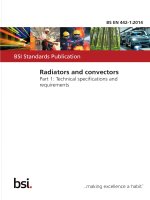Bsi bs en 61291 1 2012
Bạn đang xem bản rút gọn của tài liệu. Xem và tải ngay bản đầy đủ của tài liệu tại đây (1.29 MB, 36 trang )
BS EN 61291-1:2012
BSI Standards Publication
Optical amplifiers
Part 1: Generic specification
BRITISH STANDARD
BS EN 61291-1:2012
National foreword
This British Standard is the UK implementation of EN 61291-1:2012. It is
identical to IEC 61291-1:2012. It supersedes BS EN 61291-1:2006 which is
withdrawn.
The UK participation in its preparation was entrusted by Technical Committee
GEL/86, Fibre optics, to Subcommittee GEL/86/3, Fibre optic systems and
active devices.
A list of organizations represented on this committee can be obtained on
request to its secretary.
This publication does not purport to include all the necessary provisions of a
contract. Users are responsible for its correct application.
© The British Standards Institution 2012
Published by BSI Standards Limited 2012
ISBN 978 0 580 75891 1
ICS 33.180.20
Compliance with a British Standard cannot confer immunity from
legal obligations.
This British Standard was published under the authority of the Standards
Policy and Strategy Committee on 30 September 2012.
Amendments issued since publication
Amd. No.
Date
Text affected
BS EN 61291-1:2012
EUROPEAN STANDARD
EN 61291-1
NORME EUROPÉENNE
EUROPÄISCHE NORM
August 2012
ICS 33.180.30
Supersedes EN 61291-1:2006
English version
Optical amplifiers Part 1: Generic specification
(IEC 61291-1:2012)
Amplificateurs optiques Partie 1: Spécification générique
(CEI 61291-1:2012)
Lichtwellenleiter-Verstärker Teil 1: Fachgrundspezifikation
(IEC 61291-1:2012)
This European Standard was approved by CENELEC on 2012-05-09. CENELEC members are bound to comply
with the CEN/CENELEC Internal Regulations which stipulate the conditions for giving this European Standard
the status of a national standard without any alteration.
Up-to-date lists and bibliographical references concerning such national standards may be obtained on
application to the CEN-CENELEC Management Centre or to any CENELEC member.
This European Standard exists in three official versions (English, French, German). A version in any other
language made by translation under the responsibility of a CENELEC member into its own language and notified
to the CEN-CENELEC Management Centre has the same status as the official versions.
CENELEC members are the national electrotechnical committees of Austria, Belgium, Bulgaria, Croatia, Cyprus,
the Czech Republic, Denmark, Estonia, Finland, Former Yugoslav Republic of Macedonia, France, Germany,
Greece, Hungary, Iceland, Ireland, Italy, Latvia, Lithuania, Luxembourg, Malta, the Netherlands, Norway, Poland,
Portugal, Romania, Slovakia, Slovenia, Spain, Sweden, Switzerland, Turkey and the United Kingdom.
CENELEC
European Committee for Electrotechnical Standardization
Comité Européen de Normalisation Electrotechnique
Europäisches Komitee für Elektrotechnische Normung
Management Centre: Avenue Marnix 17, B - 1000 Brussels
© 2012 CENELEC -
All rights of exploitation in any form and by any means reserved worldwide for CENELEC members.
Ref. No. EN 61291-1:2012 E
BS EN 61291-1:2012
EN 61291-1:2012
-2-
Foreword
The text of document 86C/1013/CDV, future edition 3 of IEC 61291-1, prepared by SC 86C ”Fibre
optic systems and active devices“, of IEC/TC 86 "Fibre optics" was submitted to the IEC-CENELEC
parallel vote and approved by CENELEC as EN 61291-1:2012.
The following dates are fixed:
•
latest date by which the document has
to be implemented at national level by
publication of an identical national
standard or by endorsement
(dop)
2013-02-10
•
latest date by which the national
standards conflicting with the
document have to be withdrawn
(dow)
2015-05-09
This document supersedes EN 61291-1:2006.
EN 61291-1:2012 includes
EN 61291-1:2006:
the
following
significant
technical
changes
with
respect
to
The definitions related to transient behaviour have been extensively updated with terms from the
EN 61290-4 series and the definition for gain ripple has been added.
Attention is drawn to the possibility that some of the elements of this document may be the subject of
patent rights. CENELEC [and/or CEN] shall not be held responsible for identifying any or all such
patent rights.
Endorsement notice
The text of the International Standard IEC 61291-1:2012 was approved by CENELEC as a European
Standard without any modification.
In the official version, for Bibliography, the following notes have to be added for the standards indicated:
IEC 60793-2
NOTE
Harmonised as EN 60793-2.
IEC 60825-1
NOTE
Harmonised as EN 60825-1.
IEC 60825-2
NOTE
Harmonised as EN 60825-2.
IEC 60874-1
NOTE
Harmonised as EN 60874-1.
BS EN 61291-1:2012
EN 61291-1:2012
-3-
Annex ZA
(normative)
Normative references to international publications
with their corresponding European publications
The following documents, in whole or in part, are normatively referenced in this document and are
indispensable for its application. For dated references, only the edition cited applies. For undated
references, the latest edition of the referenced document (including any amendments) applies.
NOTE When an international publication has been modified by common modifications, indicated by (mod), the relevant EN/HD
applies.
Publication
Year
IEC 61290
Title
EN/HD
Year
Series Optical amplifiers - Test methods
EN 61290
Series
IEC 61290-1-1
-
Optical amplifiers - Test methods Part 1-1: Power and gain parameters Optical spectrum analyzer method
EN 61290-1-1
-
IEC 61290-1-2
-
Optical amplifiers - Test methods Part 1-2: Power and gain parameters –
Electrical spectrum analyzer method
EN 61290-1-2
-
IEC 61290-1-3
-
Optical amplifiers – Test methods Part 1-3: Power and gain parameters Optical power meter method
EN 61290-1-3
-
IEC 61290-3-1
-
Optical amplifiers - Test methods Part 3-1: Noise figure parameters - Optical
spectrum analyzer method
EN 61290-3-1
-
IEC 61290-3-2
-
Optical amplifiers - Test methods EN 61290-3-2
Part 3-2: Noise figure parameters - Electrical
spectrum analyzer method
-
IEC 61290-4-1
-
Optical amplifiers - Test methods Part 4-1: Gain transient parameters - twowavelength method
EN 61290-4-1
-
IEC 61290-4-2
-
Optical amplifiers - Test methods Part 4-2: Gain transient parameters Broadband source method
EN 61290-4-2
-
IEC 61290-5-1
-
Optical amplifiers - Test methods Part 5-1: Reflectance parameters - Optical
spectrum analyzer method
EN 61290-5-1
-
IEC 61290-5-2
-
EN 61290-5-2
Optical amplifiers - Test methods Part 5-2: Reflectance parameters - Electrical
spectrum analyser method
-
IEC 61290-5-3
-
Optical fibre amplifiers - Basic specification - EN 61290-5-3
Part 5-3: Test methods for reflectance
parameters - Reflectance tolerance using an
electrical spectrum analyser
-
IEC 61290-6-1
-
Optical fibre amplifiers - Basic specification - EN 61290-6-1
Part 6-1: Test methods for pump leakage
parameters - Optical demultiplexer
-
IEC 61290-7-1
-
Optical amplifiers - Test methods Part 7-1: Out-of-band insertion losses Filtered optical power meter method
EN 61290-7-1
-
BS EN 61291-1:2012
EN 61291-1:2012
-4-
Publication
Year
Title
EN/HD
Year
IEC 61290-10-1
-
Optical amplifiers - Test methods EN 61290-10-1
Part 10-1: Multichannel parameters - Pulse
method using an optical switch and optical
spectrum analyser
-
IEC 61290-10-2
-
EN 61290-10-2
Optical amplifiers - Test methods Part 10-2: Multichannel parameters - Pulse
method using a gated optical spectrum
analyzer
-
IEC 61290-10-3
-
EN 61290-10-3
Optical amplifiers - Test methods Part 10-3: Multichannel parameters - Probe
methods
-
IEC 61290-10-4
-
Optical amplifiers - Test methods Part 10-4: Multichannel parameters Interpolated source subtraction method
using an optical spectrum analyzer
EN 61290-10-4
-
IEC 61290-11-1
-
Optical amplifier - Test methods Part 11-1: Polarization mode dispersion
parameter - Jones matrix eigenanalysis
(JME)
EN 61290-11-1
-
IEC 61290-11-2
-
Optical amplifiers - Test methods Part 11-2: Polarization mode dispersion
parameter - Poincaré sphere analysis
method
EN 61290-11-2
-
IEC 61291-2
-
Optical amplifiers Part 2: Digital applications - Performance
specification template
EN 61291-2
-
IEC 61291-4
-
Optical amplifiers Part 4: Multichannel applications Performance specification template
EN 61291-4
-
IEC 61291-5-2
-
Optical amplifiers Part 5-2: Qualification specifications Reliability qualification for optical fibre
amplifiers
EN 61291-5-2
-
IEC/TR 61292-3
-
IEC Guide 107
-
Optical amplifiers Part 3: Classification, characteristics and
applications
Electromagnetic compatibility - Guide to the drafting of electromagnetic compatibility
publications
-
–2–
BS EN 61291-1:2012
61291-1 © IEC:2012
CONTENTS
1
Scope and object .............................................................................................................. 5
2
Normative references ....................................................................................................... 5
3
Terms, definitions and abbreviations ................................................................................ 6
3.1
3.2
4
Overview ................................................................................................................. 6
Terms and definitions .............................................................................................. 8
3.2.1 OA devices and distributed amplifiers .......................................................... 8
3.2.2 OA-assemblies .......................................................................................... 20
3.3 Abbreviated terms ................................................................................................. 23
Classification .................................................................................................................. 24
5
Requirements ................................................................................................................. 25
5.1
5.2
5.3
6
Preferred values .................................................................................................... 25
Sampling ............................................................................................................... 25
Product identification for storage and shipping ...................................................... 25
5.3.1 Marking ..................................................................................................... 25
5.3.2 Labelling.................................................................................................... 25
5.3.3 Packaging ................................................................................................. 25
Quality assessment ........................................................................................................ 25
7
Electromagnetic compatibility (EMC) requirements ......................................................... 25
8
Test methods ................................................................................................................. 26
Bibliography .......................................................................................................................... 27
Index of definitions ............................................................................................................... 28
Figure 1 – OA device and assemblies ..................................................................................... 7
Figure 2 – Optical amplifier in a multichannel application ........................................................ 8
Table 1 – Grouping of parameters and corresponding test methods or references ................ 26
BS EN 61291-1:2012
61291-1 © IEC:2012
–5–
OPTICAL AMPLIFIERS –
Part 1: Generic Specification
1
Scope and object
This part of IEC 61291 applies to all commercially available optical amplifiers (OAs) and
optically amplified assemblies. It applies to OAs using optically pumped fibres (OFAs based
either on rare-earth doped fibres or on the Raman effect), semiconductors (SOAs), and
waveguides (POWAs). The object of this standard is:
–
to establish uniform requirements for transmission, operation, reliability and environmental
properties of OAs;
–
to provide assistance to the purchaser in the selection of consistently high-quality OA
products for his particular applications.
Parameters specified for OAs are those characterizing the transmission, operation, reliability
and environmental properties of the OA seen as a “black box” from a general point of view. In
the sectional and detail specifications a subset of these parameters will be specified
according to the type and application of the particular OA device or assembly.
2
Normative references
The following documents, in whole or in part, are normatively referenced in this document and
are indispensable for its application. For dated references, only the edition cited applies. For
undated references, the latest edition of the referenced document (including any
amendments) applies.
IEC 61290 (all parts), Optical amplifiers –Test methods
IEC 61290-1-1, Optical amplifiers – Test methods – Part 1-1: Power and gain parameters –
Optical spectrum analyzer method
IEC 61290-1-2, Optical amplifiers – Test methods – Part 1-2: Power and gain parameters –
Electrical spectrum analyzer method
IEC 61290-1-3, Optical amplifiers – Test methods – Part 1-3: Power and gain parameters –
Optical power meter method
IEC 61290-3-1, Optical amplifiers – Test methods – Part 3-1: Noise figure parameters –
Optical spectrum analyzer method
IEC 61290-3-2, Optical amplifiers – Test methods – Part 3-2: Noise figure parameters –
Electrical spectrum analyzer method
IEC 61290-4-1, Optical amplifiers – Test methods – Part 4-1: Gain transient parameters –
Two wavelength method
IEC 61290-4-2, Optical amplifiers – Test methods – Part 4-2: Gain transient parameters –
Broadband source method
IEC 61290-5-1, Optical amplifiers – Test methods – Part 5-1: Reflectance parameters –
Optical spectrum analyzer method
–6–
BS EN 61291-1:2012
61291-1 © IEC:2012
IEC 61290-5-2, Optical amplifiers – Test methods – Part 5-2: Reflectance parameters –
Electrical spectrum analyzer method
IEC 61290-5-3, Optical fibre amplifiers – Basic specification– Part 5-3: Test methods for
reflectance parameters – Reflectance tolerance using an electrical spectrum analyzer
IEC 61290-6-1, Optical fibre amplifiers – Basic specification – Part 6-1: Test methods for
pump leakage parameters – Optical demultiplexer
IEC 61290-7-1, Optical amplifiers – Test methods – Part 7-1: Out-of-band insertion losses –
Filtered optical power meter method
IEC 61290-10-1, Optical amplifiers – Test methods – Part 10-1: Multichannel parameters –
Pulse method using an optical switch and optical spectrum analyzer
IEC 61290-10-2, Optical amplifiers – Test methods – Part 10-2: Multichannel parameters –
Pulse method using a gated optical spectrum analyzer
IEC 61290-10-3, Optical amplifiers – Test methods – Part 10-3: Multichannel parameters –
Probe methods
IEC 61290-10-4, Optical amplifiers – Test methods – Part 10-4: Multichannel parameters –
Interpolated source subtraction method using an optical spectrum analyzer
IEC 61290-11-1, Optical amplifiers – Test methods – Part 11-1: Polarization mode dispersion
parameter – Jones matrix eigenanalysis (JME)
IEC 61290-11-2, Optical amplifiers – Test methods – Part 11-2: Polarization mode dispersion
parameter – Poincaré sphere analysis method
IEC 61291-2, Optical amplifiers – Part 2: Digital applications – Performance specification
template
IEC 61291-4, Optical amplifiers – Part 4: Multichannel applications – Performance specification template
IEC 61291-5-2, Optical amplifiers – Part 5-2: Qualification specifications – Reliability
qualification for optical fibre amplifiers
IEC/TR 61292-3, Optical amplifiers – Part 3: Classification, characteristics and applications
IEC Guide 107, Electromagnetic compatibility – Guide to the drafting of electromagnetic
compatibility publications
3
Terms, definitions and abbreviations
3.1
Overview
The definitions listed in this clause refer to the meaning of the terms used in the specifications
of OAs. Only those parameters listed in the appropriate specification template, as in
IEC 61291-2 and IEC 61291-4, are intended to be specified.
NOTE 1
The numbered terms in this clause are indexed and cross-referenced in Annex A.
The list of parameter definitions of OAs, given in this clause, is divided into two parts: the first
part, in 3.1.2, lists those parameters relevant for OA devices, namely power, pre-, line- and
BS EN 61291-1:2012
61291-1 © IEC:2012
–7–
distributed amplifiers; the second part, in 3.2, lists the parameters relevant for optically
amplified, elementary assemblies, namely the optically amplified transmitter (OAT) and the
optically amplified receiver (OAR).
In any case where the value of a parameter is given for a particular device, it will be
necessary to specify certain appropriate operating conditions such as temperature, bias
current, pump optical power, etc. In this clause, two different operating conditions are referred
to: nominal operating conditions, which are those suggested by the manufacturer for normal
use of the OA, and limit operating conditions, in which all the parameters adjustable by the
user (e.g. temperature, gain, pump laser injection current, etc.) are at their maximum values,
according to the absolute maximum ratings stated by the manufacturer.
The OA shall be considered as a “black box”, as shown in Figure 1. The OA device shall have
two optical ports, namely an input and an output port (Figure 1a)). The OAT and OAR are to
be considered as an OA integrated on the transmitter side or on the receiver side,
respectively. Both kinds of integration imply that the connection between the transmitter or the
receiver and the OA is proprietary and not to be specified. Consequently, only the optical
output port can be defined for the OAT (after the OA, as shown in Figure 1b) and only the
optical input port can be defined for the OAR (before the OA, as shown in Figure 1c)). The
optical ports may consist of unterminated fibres or optical connectors. Electrical connections
for power supply (not shown in Figure 1) are also necessary. Following this "black box"
approach, the typical loss of one connection and the corresponding uncertainty will be
included within the values of gain, noise figure and other parameters of the OA device.
NOTE 2 For distributed amplifiers, as described in Clause 4, this black-box configuration may be simulated for
test purposes, for example by attaching a reference fibre to test a Raman pump unit.
Input
port
OA
Output
port
Tx
OA
Output
port
Input
port
OA
Rx
IEC 1483/06
Figure 1a – OA device
Figure 1b – OAT
Figure 1c – OAR
Figure 1 – OA device and assemblies
The OA amplifies signals in a nominal operating wavelength region. In addition, other signals
outside of the band of operating wavelength can in some applications, also cross the OA. The
purpose of these out-of-band signals and their wavelength, or wavelength region, can be
specified in the detail specifications.
When signals at multiple wavelengths are incident on the OA, as is the case in multichannel
systems, suitable adjustment of the definitions of some existing relevant parameters is
needed together with the introduction of definitions of new parameters relevant to this
different application.
A typical configuration of an OA in a multichannel application is shown in Figure 2. At the
transmitting side m signals, coming from m optical transmitters, Tx 1 , Tx 2 , . . . Tx m , each with a
unique wavelength, λ 1 , λ 2 , . . . λ m , respectively, are combined by an optical multiplexer (OM).
At the receiving side the m signals at λ 1 , λ 2 , . . . λ m , are separated with an optical
demultiplexer (OD) and routed to separate optical receivers, Rx 1 , Rx 2 , . . . Rx m , respectively.
To characterize the OA in this multichannel application, an input reference plane and an
output reference plane are defined at the OA input and output ports, respectively, as shown in
Figure 2.
BS EN 61291-1:2012
61291-1 © IEC:2012
–8–
Input
reference
plane
Tx1
Output
reference
plane
Rx1
Tx2
Rx2
OM
Pi1
Pi2
Txm
OD
OA
OA
Po1
Po2
...
...
Pim
Pom
Rxm
PASE(λ)
IEC 1484/06
Figure 2 – Optical amplifier in a multichannel application
At the input reference plane, m input signals at the m wavelengths are considered, each with a
unique power level, P i1 , P i2 , . . . P im , respectively. At the output reference plane, m output
signals at the m wavelengths, resulting from the optical amplification of the corresponding m
input signals, are considered, each with power level P o1 , P o2 , . . . P om , respectively. Moreover,
the amplified spontaneous emission, ASE, with a noise power spectral density, P ASE (λ), is
also to be considered at the OA output port.
Most definitions of relevant single-channel parameters can be suitably extended to
multichannel applications. When this extension is straightforward, the word “channel” will be
added to the pertinent parameter. In particular, the noise figure and the signal-spontaneous
noise figure may be extended to multichannel applications, channel by channel, by
considering the value of P ASE (λ) at each channel wavelength and the channel signal
bandwidth. For each channel wavelength there will be a unique value of noise figure that will
be a function of the input power level of all signals. In this case the parameters, channel noise
figure and channel signal-spontaneous noise figure, are introduced. However some additional
parameters also need to be defined. For each parameter, the particular multichannel
configuration, including the full set of channel signal wavelengths and input powers, needs to
be specified.
NOTE 3
Except where noted, the optical powers mentioned in the following are intended as average powers.
NOTE 4 The parameters defined below will in general depend also on temperature and polarization state of input
channels. The temperature and state of polarization should be kept constant or controlled or be measured and
reported together with the measured parameter.
NOTE 5 It should be noted that the measured optical powers are open beam powers: this can result in differences
of about 0,18 dB in the measurement of absolute power levels.
NOTE 6 In the case of the distributed amplifier, all the parameters are related to a suitable reference fibre used to
emulate the transmission fibre in conjunction with the pumping assembly.
3.2
3.2.1
Terms and definitions
OA devices and distributed amplifiers
For the purposes of this document, the following terms and definitions apply.
NOTE These terms and conditions furthermore apply, in general, to optical amplifiers under the IEC 61290 and
IEC 61291 series.
BS EN 61291-1:2012
61291-1 © IEC:2012
–9–
3.2.1.1
gain
in an OA which is externally connected to an input jumper fibre, the increase of signal optical
power from the output end of the jumper fibre to the OA output port, expressed in dB
Note 1 to entry:
The gain includes the connection loss between the input jumper fibre and the OA input port.
Note 2 to entry:
port of the OA.
It is assumed that the jumper fibres are of the same type as the fibres used as input and output
Note 3 to entry:
optical powers.
Care should be taken to exclude the amplified spontaneous emission power from the signal
3.2.1.2
small-signal gain
gain of the amplifier, when operated in linear regime, where it is essentially independent of
the input signal optical power, at a given signal wavelength and pump optical power level
Note 1 to entry:
This property can be described at a discrete wavelength or as a function of wavelength.
3.2.1.3
reverse gain
gain measured using the input port of the OA as output port and vice versa
3.2.1.4
reverse small-signal gain
small-signal gain measured using the input port of the OA as output port and vice versa
3.2.1.5
maximum gain
highest gain that can be achieved when the OA is operated within the stated nominal
operating conditions
3.2.1.6
maximum small-signal gain
highest small-signal gain that can be achieved when the OA is operated within the stated
nominal operating conditions
3.2.1.7
maximum gain wavelength
wavelength at which the maximum gain occurs
3.2.1.8
maximum small-signal gain wavelength
wavelength at which the maximum small-signal gain occurs
3.2.1.9
wavelength variation
peak-to-peak variation of the gain over a given wavelength range
3.2.1.10
small-signal gain wavelength variation
peak-to-peak variation of the small-signal gain over a given wavelength range
3.2.1.11
gain-slope under single wavelength operation (for analogue operation)
in the presence of a signal of given wavelength and input power, the derivative of the gain of
a small probe versus wavelength, at the signal wavelength
– 10 –
BS EN 61291-1:2012
61291-1 © IEC:2012
Note 1 to entry: The probe total average power level must be at least 20 dB below the input signal level, to
minimize the effect on the gain wavelength-profile.
3.2.1.12
polarization-dependent gain
PDG
the maximum variation of the OA gain due to a variation of the state of polarization of the
input signal, at nominal operating conditions
Note 1 to entry:
inside.
A source of PDG in OAs is the polarization dependent loss of the passive components used
3.2.1.13
channel gain (for multichannel operation)
gain for each channel (at wavelength λ j ) in a specified multichannel configuration
Channel gain can be expressed as follows (P ij and P oj being respectively the input and output
power levels, in dBm, of the j-th channel and j = 1, 2, . . . n; n total number of channels):
G j = P oj – P ij
Note 1 to entry:
Channel gain is expressed in dB.
Note 2 to entry: Since the amplifier saturation power level is determined by the combined effect of the input
signals at all wavelengths, the channel gain is dependent on the input power level of all signals.
3.2.1.14
multichannel gain variation (interchannel gain difference) (for multichannel operation)
difference between the channel gains of any two of the channels in a specified multichannel
configuration
Multichannel gain variation can be expressed as follows (G j and G l being respectively the
channel gains of j-th and l-th channel and j, l = 1, 2, . . . n; j ≠ l; n total number of channels):
ΔG jl = G j – G l
Note 1 to entry:
Multichannel gain variation is expressed in dB.
Note 2 to entry: Normally this parameter is specified as the maximum multichannel gain variation, intended as the
maximum absolute value of multichannel gain variation, considering all possible combinations of channel pairs. The
input power levels would normally be set to their minimum and maximum specified values. Input power levels may
also be specified to achieve certain gain values or total output power levels. Maximum multichannel gain variation
can be expressed as follows:
ΔG MAX = MAX j , l {|ΔG jl |}
Note 3 to entry:
Maximum multichannel gain variation is expressed in dB.
Note 4 to entry:
This parameter is often referred to as gain flatness.
3.2.1.15
gain cross-saturation (for multichannel operation)
ratio of the change in channel gain of one channel, ΔG j , to a given change in the input power
level of another channel, ΔP l , while the input power levels of all other channels are kept
constant, in a specified multichannel configuration
Gain cross-saturation can be expressed as follows (j, l = 1, 2, . . . , n; j ≠ l; n total number of
channels):
GXS jl = ΔG j /ΔP l
Note 1 to entry:
Gain cross-saturation is expressed in dB per dB.
Note 2 to entry: Normally, this parameter is specified for an initial input power distribution among channels in
which each channel is at the minimum allowed power level. Other distributions may be indicated in the appropriate
product specification.
BS EN 61291-1:2012
61291-1 © IEC:2012
– 11 –
3.2.1.16
interchannel crosstalk (for multichannel operation)
under consideration.
3.2.1.17
multichannel
gain-change
difference
(interchannel
gain-change
difference)
(multichannel)
for a specified channel allocation, the difference of change in gain in one channel with respect
to the change in gain of another channel for two specified sets of channel input powers
(1)
(2)
(1)
(2)
Multichannel gain-change difference can be expressed as follows (G j , G j and G l , G l
being the channel gains of the j-th and l-th channel at each of the two specified sets of
channel input power (1) and (2) respectively, and j, l = 1, 2, . . . n; n total number of
channels):
GD jl = [G j
Note 1 to entry:
(1)
(2)
– G j ] – [G l
(1)
(2)
– Gl ]
Multichannel gain-change difference is expressed in dB.
Note 2 to entry: The two specified sets of channel input power are in general: (1) all input power levels set to the
minimum value and (2) all input power levels set to the maximum value.
Note 3 to entry: Normally, the maximum multichannel gain-change difference will be specified. Different sets of
input conditions could be defined in the appropriate product specification.
Note 4 to entry: Forward ASE power level can be relevant for OA’s used as pre-amplifiers or line amplifiers. In
this case the channel input power will include the forward ASE contribution coming from previous OAs.
Note 5 to entry: This parameter can be used instead of the multichannel gain tilt when the definition of the gain tilt
cannot be applied.
3.2.1.18
multichannel gain tilt (interchannel gain-change ratio or dynamic gain tilt – DGT) for
multichannel operation
ratio of the changes in gain in each channel to the change in gain at a reference channel as
the input conditions are varied from one set of input channel powers to a second set of input
channel powers
(2)
(1)
(2)
Multichannel gain tilt can be expressed as follows (G j (1) , G j and G r , G r being respectively
the channel gains of the j-th and the reference channel at each of the two specified sets of
channel input power and j = 1, 2, . . . n; n total number of channels):
GT j = [G j
Note 1 to entry:
(1)
(2)
– G j ] / [G r
(1)
(2)
– Gr ]
Multichannel gain tilt is expressed in dB per dB.
Note 2 to entry: Multichannel gain tilt is normally used to predict the gains for each channel for various sets of
input channel powers based on observed changes in the reference channel.
Note 3 to entry: The sets of input channel powers are generally those in which (1) all power levels are set equal
to the maximum allowed and (2) all powers are set equal to the minimum allowed.
Note 4 to entry: The reference channel should be specified in the appropriate product specification. The
multichannel gain tilt of the reference channel is by definition equal to 1 dB/dB.
Note 5 to entry: Application of multichannel gain tilt to prediction of channel gain in different conditions could be
impaired in the case of hybrid multistage amplifiers, inhomogeneous gain media and in particular for amplifiers with
automatic gain control.
3.2.1.19
(removed)
3.2.1.20
(removed)
– 12 –
BS EN 61291-1:2012
61291-1 © IEC:2012
3.2.1.21
(removed)
3.2.1.22
on-off gain (only applicable to distributed amplifier)
the increase in signal optical power from the output of an optical fibre providing distributed
amplification when the pumping is active compared to when the pumping is disabled,
expressed in dB. This is sometimes referred to as "effective gain".
Note 1 to entry: The on-off gain differs from gain in that it does not compare the output signal power with the input
signal power, since this includes the attenuation of the fibre and this loss can be associated with the transmission
system rather than the amplifier. The value for on-off gain is thus higher than for gain by the amount of passive
loss between the input and output.
3.2.1.23
net on-off gain (only applicable to distributed amplifier)
the increase in signal optical power from the output of an optical fibre providing distributed
amplification when the pumping is active compared to when no additional fibre optic
equipment is installed to the fibre for the purpose of providing distributed amplification
3.2.1.24
wavelength band
the wavelength range within which the OA output signal power is maintained in the specified
output power range, when the corresponding input signal power lies within the specified input
power range
3.2.1.25
available signal wavelength band (for pre-amplifiers with optical filter(s) only)
the resulting pre-amplifier wavelength band including the effect of optical filter(s)
3.2.1.26
tunable wavelength range (for pre-amplifiers with tunable optical filter(s) only)
the wavelength range, of the wavelength band, within which the tunable optical filter(s) inside
the pre-amplifier can be tuned
3.2.1.27
channel allocation (for multichannel operation)
channel allocation is given by the number of channels, the nominal central
frequencies/wavelengths of the channels and their central frequency/wavelength tolerance
3.2.1.28
gain stability
degree of gain fluctuation expressed by the ratio (in dB) of the maximum and minimum gain,
for a certain specified test period, under nominal operating conditions
3.2.1.29
small-signal gain stability
degree of small-signal gain fluctuation expressed by the ratio (in dB) of the maximum and
minimum small-signal gain, for a certain specified test period, under nominal operating
conditions
3.2.1.30
maximum gain variation with temperature
change in gain for temperature variation within a specified range, expressed in dB
3.2.1.31
maximum small-signal gain variation with temperature
change in small-signal gain for temperature variation within a specified range, expressed in
dB
BS EN 61291-1:2012
61291-1 © IEC:2012
– 13 –
3.2.1.32
large-signal output stability
degree of output optical power fluctuation expressed by the ratio (in dB) of the maximum and
minimum output signal optical powers, for a certain specified test period, under nominal
operating conditions and a specified large input signal optical power
3.2.1.33
saturation output power (gain compression power)
optical power level associated with the output signal above which the gain is reduced by N dB
(typically N = 3) with respect to the small-signal gain at the signal wavelength
Note 1 to entry:
The wavelength at which the parameter is specified should be stated.
3.2.1.34
nominal output signal power
minimum output signal optical power for a specified input signal optical power, under nominal
operating conditions
3.2.1.35
maximum output signal power
highest optical power associated with the output signal that can be obtained from the OA at
nominal operating conditions
3.2.1.36
input power range
range of optical power levels such that, for any input signal power of the OA which lies in this
range, the corresponding output signal optical power lies in the specified output power range,
where the OA performance is ensured
3.2.1.37
output power range
range of optical power levels in which the output signal optical power of the OA lies when the
corresponding input signal power lies in the specified input power range, where the OA
performance is ensured
3.2.1.38
noise figure
NF
decrease of the signal-to-noise ratio (SNR), at the output of an optical detector with unitary
quantum efficiency and zero excess noise, due to the propagation of a shot noise-limited
signal through the OA, expressed in decibels (dB)
Note 1 to entry:
The operating conditions at which the noise figure is specified should be stated.
Note 2 to entry:
This property can be described as a discrete wavelength or as a function of wavelength.
Note 3 to entry: The noise degradation due to the OA, is attributable to different factors, e.g. signal-spontaneous
beat noise, spontaneous-spontaneous beat noise, internal reflections noise, signal shot noise, spontaneous shot
noise. Each of these factors depends on various conditions which should be specified for a correct evaluation of
the noise figure.
Note 4 to entry:
By convention this noise figure is a positive number.
Note 5 to entry: In the case of OAs for analogue applications the noise figure also represents the ratio between
input and the output carrier-to-noise ratios.
3.2.1.39
noise factor
F
noise figure expressed in linear form
– 14 –
BS EN 61291-1:2012
61291-1 © IEC:2012
3.2.1.40
channel noise figure (for multichannel operation)
for a specified multichannel configuration, the noise figure for each channel in a specified
optical bandwidth
Note 1 to entry:
Channel noise figure is expressed in dB.
3.2.1.41
multi-path interference (MPI) figure of merit
noise factor contribution caused by multiple path interference integrated over all baseband
frequencies
NOTE
For example, multiple path interference can be caused by successive partial reflections in the optical path.
3.2.1.42
double Rayleigh scattering figure of merit
the noise factor contribution caused by multiple path interference due to Rayleigh scattering
integrated over all baseband frequencies
Note 1 to entry: Double Rayleigh scattering is particularly relevant to fibre Raman amplifiers, both distributed and
discrete, because of the long amplifying fibre lengths providing substantial amounts of scattered light together with
gain. Other fibre amplifiers with high gain and long fibres can also show this effect. The contribution becomes
larger at higher gain levels.
3.2.1.43
frequency-independent contribution to noise factor
noise factor excluding the noise contribution from multi-path interference
3.2.1.44
signal-spontaneous noise figure
NF sig-sp
signal-spontaneous beat noise contribution to the noise figure, expressed in dB
3.2.1.45
channel signal-spontaneous noise figure (for multichannel operation)
signal-spontaneous noise figure for each channel in a specified multichannel configuration,
expressed in dB
3.2.1.46
equivalent spontaneous-spontaneous optical bandwidth
B sp-sp
equivalent optical bandwidth by which the square of the ASE spectral power density, ρ ASE , at
the signal optical frequency, ν SIG , is multiplied in order to obtain the integral of the squared
ASE spectral power density over the full ASE bandwidth, B ASE , that is:
( )∫
−2
2
(ν )dν
Bsp − sp = ρ ASE
νsig ⋅
ρ ASE
BASE
Note 1 to entry: The equivalent spontaneous-spontaneous optical bandwidth can be minimized by using an optical
filter at the output of the OA.
Note 2 to entry: This parameter is related to the spontaneous-spontaneous beat noise generation and thus it
requires the use of the squared ASE spectral power density.
3.2.1.47
equivalent total noise figure (only applicable to distributed amplifier)
the decrease of the signal-to-noise ratio (SNR) at the output of an optical detector with unitary
quantum efficiency and zero excess noise, due to the propagation of a shot-noise-limited
signal through an optical fibre providing distributed amplification when the pumping is active
compared to when the pumping is disabled, expressed in dB
BS EN 61291-1:2012
61291-1 © IEC:2012
– 15 –
Note 1 to entry: The effective noise figure differs from the noise figure in that it does not compare the SNR at the
output with the SNR at the input of the amplifier. The increase in signal strength relevant to the change in SNR is
thus the effective gain rather than the gain. In particular the contribution of signal-spontaneous noise figure, which
can be calculated from the difference between ASE power and gain expressed in dB, is then reduced in the
effective noise figure by the amount of passive loss between the input and output. It is thus possible for the
effective noise figure of distributed amplification to be negative, expressed in dB.
Note 2 to entry: The effective noise figure can be understood as the noise figure of an equivalent discrete optical
amplifier placed at the end of the optical fibre, which produces the effective gain and the same ASE output power
as the distributed amplification. Because the ASE produced within the fibre of the distributed amplifier is also
partially reduced by the attenuation of this fibre, the ASE output power can be lower than physically realisable from
such a discrete amplifier.
3.2.1.48
equivalent signal-spontaneous noise figure (only applicable to distributed amplifier)
the signal-spontaneous beat noise contribution to the equivalent total noise figure
3.2.1.49
polarization mode dispersion
PMD
when an optical signal travels through an optical fibre, component or assembly (such as an
optical amplifier), the change in the shape and rms width of the pulse due to the average
propagation delay difference between the two principal states of polarisation (PSPs), that is
differential group delay (DGD), and to the waveform distortion for each PSP, is called PMD.
PMD, together with polarization dependent loss (PDL) and polarization dependent gain
(PDG), may introduce large waveform distortion leading to unacceptable bit error ratio
increase.
Note 1 to entry:
PMD may depend on temperature and operating conditions.
3.2.1.50
principal states of polarization
PSP
at a given frequency (or wavelength), the two orthogonal input states of polarization for which
the corresponding output states of polarization (SOPs) are independent of optical frequency
to first order
Note 1 to entry: An optical fibre, component or sub-system is typically characterized by two PSPs that are a
function of the intrinsic birefringence of the material and the induced external and internal stresses acting on it.
Note 2 to entry:
The DGD between these two PSPs can vary with time and wavelength.
Note 3 to entry: A signal whose SOP is aligned with one of the PSPs will be unaffected by the amount of PMD, at
least to first order.
3.2.1.51
forward ASE power level
optical power in a specified wavelength range associated with the ASE (amplified
spontaneous emission) exiting the optical output port, under nominal operating conditions
Note 1 to entry: This parameter is particularly important for OAs used as pre-amplifiers or line amplifiers, and it
depends mainly on the filter used.
Note 2 to entry: The operating conditions (e.g. the gain and input signal optical power) at which the ASE level is
specified should be stated.
3.2.1.52
reverse ASE power level
optical power in a specified wavelength range associated with the ASE exiting the optical
input port, under nominal operating conditions
3.2.1.53
ASE bandwidth
span between the two wavelengths at which a specified decrease of the output ASE from the
peak value of the output ASE spectrum is observed
– 16 –
Note 1 to entry:
BS EN 61291-1:2012
61291-1 © IEC:2012
A decrease of 30 dB to 40 dB is considered to be adequate.
Note 2 to entry: Due to possible distortion of the measured spectrum, e.g. caused by pump leakage, a suitable
extrapolation may be necessary.
3.2.1.54
maximum input reflectance
maximum fraction of incident optical power, at the operating wavelength and over all states of
input light polarization, reflected by the OA from the input port, under nominal specified
operating conditions, expressed in dB
Note 1 to entry:
The measurement is performed with a given input signal optical power.
3.2.1.55
minimum input reflectance
minimum fraction of incident optical power, at the operating wavelength and over all states of
input light polarization, reflected by the OA from the input port, under nominal specified
operating conditions, expressed in dB
Note 1 to entry:
The measurement is performed with a given input signal optical power.
3.2.1.56
output reflectance
fraction of incident optical power, at the operating wavelength, reflected by the OA from the
output port, under nominal operating conditions, expressed in dB
Note 1 to entry:
The measurement is performed with a given input signal optical power.
3.2.1.57
maximum reflectance tolerable at input
maximum fraction of power, expressed in dB, exiting the input optical port of the OA, reflected
into the OA itself, for which the device still meets its specifications
Note 1 to entry:
The measurement is performed with a given input signal optical power.
Note 2 to entry:
The noise figure is the most sensitive parameter to reflectance.
3.2.1.58
maximum reflectance tolerable at output
maximum fraction of power, expressed in dB, exiting the optical output port of the OA,
reflected into the OA itself, for which the device still meets its specifications
Note 1 to entry:
The measurement is performed with a given input signal optical power.
Note 2 to entry:
The noise figure is the most sensitive parameter to reflectance.
3.2.1.59
maximum reflectance tolerable at input and output
maximum reflectance of two identical reflectors simultaneously placed at both input and
output ports of an OA, for which the OA still meets its specifications
Note 1 to entry:
The measurement is performed with a given input signal optical power.
Note 2 to entry:
The noise figure is the most sensitive parameter to reflectance.
3.2.1.60
pump leakage to output
pump optical power which is emitted from the OA output port
Note 1 to entry:
The measurement is performed with a given input signal optical power.
Note 2 to entry:
The maximum pump leakage to output occurs for no input signal.
BS EN 61291-1:2012
61291-1 © IEC:2012
– 17 –
3.2.1.61
pump leakage to input
pump optical power which is emitted from the OA input port
Note 1 to entry:
The measurement is performed with a given input signal optical power.
Note 2 to entry:
The maximum pump leakage to input occurs for no input signal.
3.2.1.62
degree of polarization
DOP
(applicable to pumping devices for fibre Raman amplifiers)
for each emission wavelength of the optical pump source, the value
Pmax − Pmin
,
Pmax + Pmin
expressed as a percent, where P max and P min are respectively the maximum and minimum
optical output powers of the pump source over all states of polarization at that wavelength of
emission and measured within a specified bandwidth
Note 1 to entry: Because the Raman effect exploited in Raman amplifiers is polarization dependent, the degree of
polarization can influence the polarization-dependent gain of the amplifier.
Note 2 to entry: Because Raman amplifiers are often pumped with multiple wavelengths and multimode lasers, it
is necessary to determine separately the degree of polarization at every wavelength of emission, rather than just
the degree of polarization of the total optical output.
3.2.1.63
out-of-band insertion loss
OA insertion loss for a signal at the specified out-of-band wavelength(s)
3.2.1.64
out-of-band reverse insertion loss
OA insertion loss for a signal at the specified out-of-band wavelength(s), measured using the
input port of the OA as output port and vice versa
3.2.1.65
in-band insertion loss
in an electrically unpowered condition, the insertion loss of signal for the OA at a given input
signal wavelength and a given signal power level
Note 1 to entry:
Note 2 to entry:
parameter.
Note 3 to entry:
This property can be described as a discrete wavelength or as a function of wavelength.
Care should be taken to exclude the output ASE contribution in the measurement of this
The in-band insertion loss is a function of the input signal power level.
3.2.1.66
powering and control requirements
those electrical currents and/or voltages as well as those electrical signals necessary for OA
operation within the stated maximum ratings
Note 1 to entry: Necessary tolerances on electrical powering and switching on and off procedures are included.
3.2.1.67
maximum power consumption
electrical power needed by OA operating within the absolute maximum ratings
3.2.1.68
external dimensions and weight
maximum height, length, width and weight of the OA
– 18 –
BS EN 61291-1:2012
61291-1 © IEC:2012
3.2.1.69
environmental conditions
range of temperature, humidity and vibration level within which the OA can be stored, or
operated, or shipped and still meet all its specified parameter values
3.2.1.70
operating temperature
temperature range within which the OA can be operated and still meet all its specified
parameter values
3.2.1.71
maximum operating relative humidity
maximum relative humidity at which the OA can be operated and still meet all its specified
parameter values
3.2.1.72
maximum operating vibration level
maximum vibration level at which the OA can be operated and still meet all its specified
parameter values
3.2.1.73
storage temperature
temperature range within which the OA can be stored and still meet all its specified parameter
values
3.2.1.74
maximum storage relative humidity
maximum relative humidity at which the OA can be stored and still meet all its specified
parameter values
3.2.1.75
maximum transport vibration/shock level
maximum vibration and shock level that the OA can bear when shipped and still meet all its
specified parameter values
3.2.1.76
reliability
expectation of operation lifetime. The reliability of an OA is expressed by either of the
following two parameters: mean operating time between failures (MTBF) or failure in time
(FIT)
Note 1 to entry: The MTBF is the mean period of OA continuous operation without any failure at specified
operating and environmental conditions. The FIT is the number of failures in 10 9 hours at specified operating and
environmental conditions.
Note 2 to entry:
Reliability qualification is addressed by IEC 61291-5-2.
3.2.1.77
safety
precautions or agreed safety standards that installers, operators and manufacturers will
observe for safe operation with OAs
Note 1 to entry: Unless otherwise specified, IEC 60825-1 and IEC 60825-2 should be used.
3.2.1.78
maximum total output power
highest optical power level at the output port of the OA operating within the absolute
maximum ratings
BS EN 61291-1:2012
61291-1 © IEC:2012
– 19 –
3.2.1.79
remote and local alarm control
functions that can check the operation of the OA assembly, detecting and signalling possible
faults
3.2.1.80
optical connections
connector type and/or the fibre type used as input and output ports of the OA
Note 1 to entry: The optical, mechanical and environmental characteristics and performances of the optical
connectors and of the connecting fibres should be in compliance with IEC 60874-1 and IEC 60793-2, respectively.
3.2.1.81
surviving (pre-existing) signal
optical signal that remains (exists) after (before) drop (add) event
3.2.1.82
saturating signal
optical signal that is switched off (on) by the drop (add) event
3.2.1.83
drop (add) level
amount in dB by which the input power decreases (increases) due to dropping (adding) of
channels
3.2.1.84
add rise time
time it takes for the input optical signal to rise from 10 % to 90 % of the total difference
between the initial and final signal levels during an add event
3.2.1.85
drop fall time
time it takes for the input optical signal to fall from 10 % to 90 % of the total difference
between the initial and final signal levels during a drop event
3.2.1.86
initial gain
gain of the surviving (pre-existing) channel before a drop (add) event
3.2.1.87
final gain
steady state gain of the surviving (pre-existing) channel a very long time (i.e. once the gain
has stabilized) after a drop (add) event
3.2.1.88
gain offset
difference in dB between the Initial gain and the final gain
Note 1 to entry:
edition.
This term replaces “channel addition/removal steady-state gain response” from the second
3.2.1.89
transient gain response time constant (settling time)
amount of time required to bring the gain at the surviving (pre-existing) channel to the final
gain. This parameter is the measured time from the beginning of the drop (add) event that
created the transient gain response, to the time at which a surviving (pre-existing) channel
gain first enters within the gain stability band centred on the final gain.
Note 1 to entry:
This term replaces “channel addition/removal transient response time” from the second edition.
– 20 –
BS EN 61291-1:2012
61291-1 © IEC:2012
3.2.1.90
transient gain overshoot
difference in dB between the maximum surviving (pre-existing) channel gain reached during
the OFA transient response to a drop (add) event, and the lowest of either the initial gain and
final gain
Note 1 to entry: This term partially replaces and is more specific than “channel addition/removal transient gain
response” from the second edition.
3.2.1.91
transient net gain overshoot
difference in dB between the maximum surviving (pre-existing) channel gain reached during
the OFA transient response to a drop (add) event, and the highest of either the initial gain and
final gain. The transient gain net overshoot is just the transient gain overshoot minus the gain
offset, and represents the actual transient response not related to the shift of the amplifier
from the initial steady state condition to the final steady state condition.
Note 1 to entry: This term partially replaces and is more specific than “channel addition/removal transient gain
response” from the second edition.
3.2.1.92
transient gain undershoot
difference in dB between the minimum surviving (pre-existing) channel gain reached during
the OFA transient response to a drop (add) event, and the highest of either the initial gain and
final gain
Note 1 to entry: This term partially replaces and is more specific than “channel addition/removal transient gain
response” from the second edition.
3.2.1.93
transient net gain undershoot
difference in dB between the minimum surviving (pre-existing) channel gain reached during
the OFA transient response to a drop (add) event and the lowest of either the initial gain and
final gain. The transient gain net undershoot is just the transient gain undershoot minus the
gain offset and represents the actual transient response not related to the shift of the amplifier
from the initial steady state condition to the final steady state condition.
Note 1 to entry: This term partially replaces and is more specific than “channel addition/removal transient gain
response” from the second edition.
3.2.1.94
gain ripple (especially applicable to SOA devices)
The peak to peak variation of the gain over a given wavelength range with sub-nanometer
resolution in wavelength.
3.2.2
OA-assemblies
Note 1 to entry: Definitions contained in this subclause concern the relevant parameters of elementary OA
assemblies, namely, the optically amplified transmitter (OAT) and the optically amplified receiver (OAR).
3.2.2.1
Generic OA assembly
3.2.2.1.1
signal wavelength
wavelength of the signal optical carrier
3.2.2.1.2
signal linewidth
full width half maximum (FWHM) of the signal optical spectrum
BS EN 61291-1:2012
61291-1 © IEC:2012
– 21 –
3.2.2.1.3
powering and control requirements
those electrical currents and/or voltages as well as those electrical signals necessary for OA
assembly operation within the stated maximum ratings. Necessary tolerances on electrical
optical powering and switching on and off procedures are included.
3.2.2.1.4
maximum power consumption
electrical power needed to keep the OA assembly operating at the stated maximum ratings
3.2.2.1.5
operating temperature
temperature range within which the OA assembly can be operated and still meet all its
specified parameter values
3.2.2.1.6
maximum operating relative humidity
maximum relative humidity at which the OA assembly can be operated and still meet all its
specified parameter values
3.2.2.1.7
maximum operating vibration level
maximum vibration level at which the OA assembly can be operated and still meet all its
specified parameter values
3.2.2.1.8
storage temperature
temperature range within which the OA assembly can be stored and still meet all its specified
parameter values
3.2.2.1.9
maximum storage relative humidity
maximum relative humidity at which the OA assembly can be stored and still meet all its
specified parameter values
3.2.2.1.10
maximum transport vibration/shock level
maximum vibration and shock level that the OA assembly can bear when shipped and still
meet all its specified parameter values
3.2.2.1.11
safety
precautions or agreed safety standards that installers, operators and manufacturers will
observe for safe operation with OA assemblies
Note 1 to entry:
Unless otherwise specified, IEC 60825-1 and IEC 60825-2 should be used.
3.2.2.1.12
reliability
expectation of operation lifetime. The reliability of an OA assembly is expressed by either of
the following two parameters: mean operating time between failures (MTBF) or failure in time
(FIT)
Note 1 to entry: The MTBF is the mean period of continuous operation without any failure at specified operating
and environmental conditions. The FIT is the number of failures in 10 9 hours at specified operating and
environmental conditions.
Note 2 to entry:
Reliability qualification is addressed by IEC 61291-5-2.
– 22 –
BS EN 61291-1:2012
61291-1 © IEC:2012
3.2.2.1.13
remote and local alarm control
functions that can check the operation of the OA assembly, detecting and signaling possible
faults
3.2.2.2
Optically amplified transmitter (OAT) assembly
3.2.2.2.1
signal power after output connector
optical power associated with the signal exiting the optical output port of the OAT
3.2.2.2.2
operating signal wavelength range
the wavelength range within which the OAT output signal power is maintained in a specified
output power range
3.2.2.2.3
ASE power level
optical power associated with ASE (amplified spontaneous emission) exiting the optical output
port of the OAT, at nominal operating conditions
3.2.2.2.4
output reflectance
fraction of incident optical power, at the operating wavelength, reflected by the OAT from the
optical output port, at nominal operating conditions, expressed in dB
3.2.2.2.5
maximum return optical power
maximum optical power that can enter the output port of the OAT, for which the OAT still
meets its specifications
3.2.2.2.6
pump leakage to output
pump optical power which is emitted from the OAT output port, at nominal operating
conditions
Note 1 to entry:
The measurement is performed with a given signal optical power.
Note 2 to entry:
The maximum pump leakage to output occurs for no signal.
3.2.2.2.7
optical connections
connector type and/or the fibre type used as output port of the OAT
Note 1 to entry: The optical, mechanical and environmental characteristics and performances of the optical
connector and of the connecting fibre should be in compliance with IEC 60874-1 and IEC 60793-2, respectively.
3.2.2.3
Optically amplified receiver (OAR) assembly
3.2.2.3.1
sensitivity
minimum optical power associated with the input signal, immediately after the input connector,
necessary to achieve a fixed BER value (e.g. 10 –10 )
Note 1 to entry:
Other definitions may be applicable for this parameter and are under consideration.
3.2.2.3.2
operating signal wavelength range
wavelength range within which the OAR has the specified sensitivity and overload input power
at a specified BER (e.g. 10 –10 ) and at a specified bit rate









